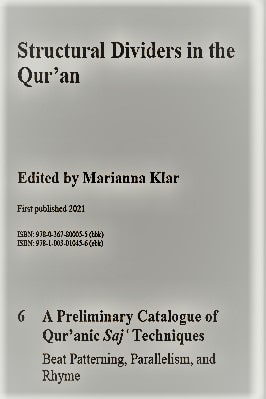
| Book Title | Structural Dividers In The Quran |
| Book Author | Rhyme Marianna Klar |
| Total Pages | 52 |
| Book Views | |
| Language | English |
| Book Download | PDF Direct Download Link |
| Get Hardcover | Click for Hard Similar Copy from Amazon |
Structural Dividers in the Quran
6 A Preliminary Catalogue of Qur’anic Sajʿ Techniques
Beat Patterning, Parallelism, and Rhyme
Marianna Klar
STRUCTURAL DIVIDERS IN THE QURAN
Introduction
This essay proposes a preliminary methodology for the division of Qur’anic pas-sages into discrete clusters of sajʿahs. The basic rules that govern Qur’anic sajʿ have already been carefully elucidated by Devin Stewart in a series of articles on this subject.1
Stewart has also provided some exploratory illustrations of where individual sajʿahs might combine to form consecutive strings of sajʿ units.2
Yet the medieval rhetorician Ḍiyāʾ al- Dīn ibn al- Athīr (d. 637/1239), in his al- Mathal al- sāʾir fī adab al- kātib wa- l-shāʿir
(“The Current Model for the Literary Discipline of the Scribe and Poet”),3 declares that it is only the occasional need for “brevity” (ījāz) and “concision” (ikhtiṣār) that precluded the Qur’an from having been written entirely in sajʿ.4
It is evident from his declaration that “the majority of the Qur’an is sajʿ” (inna akthar al- qurʾān masjūʿ) that such oft-cited examples of Qur’anic sajʿ as Q 100:1–3 (wa- l-ʿādiyāti ḍabḥā * fa- l-mūriyāti qadḥā * fa- l-mughīrāti ṣubḥā) were for Ibn al- Athīr the exception when it comes to Qur’anic sajʿ, and not the rule.5
This suggests that, at some point, many more of the Qur’an’s rhetorical features must have been seen as having being informed by the rules and the rhythms of sajʿ than the current understanding of Qur’anic sajʿ in the Western Academy might lead one to imagine.
Ibn al- Athīr provides a number of textual examples in illustration of the types of sajʿ present in the Qur’an. He does not, however, define the minutiae of sajʿ compositional techniques per se.
Nor does he explain how these might serve to demarcate the limits of structural units or how they might be juxtaposed or inter-woven in order to form complex passages that can more loosely be described as masjūʿ.
As such, his statement that it is only the occasional need for brevity and concision that precluded the Qur’an from having been written entirely in sajʿ does not immediately ring true.
That short passages of sajʿ do combine into wider masjūʿ units is evident from one of the examples of non- Qur’anic sajʿ provided by Ibn al- Athīr:6
To read more about the Structural Dividers In The Quran book Click the download button below to get it for free
Report broken link
Support this Website
Click here to join our Telegram group for new Books